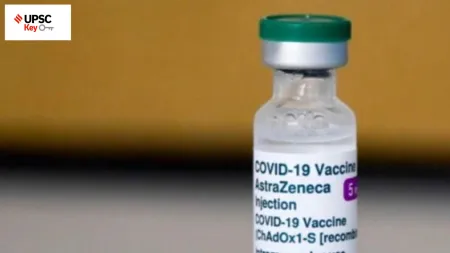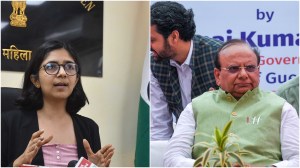- India
- International
Decoding the Indian culinary art of the achaar
A look at the condiment that is a household staple and its long history in the subcontinent.
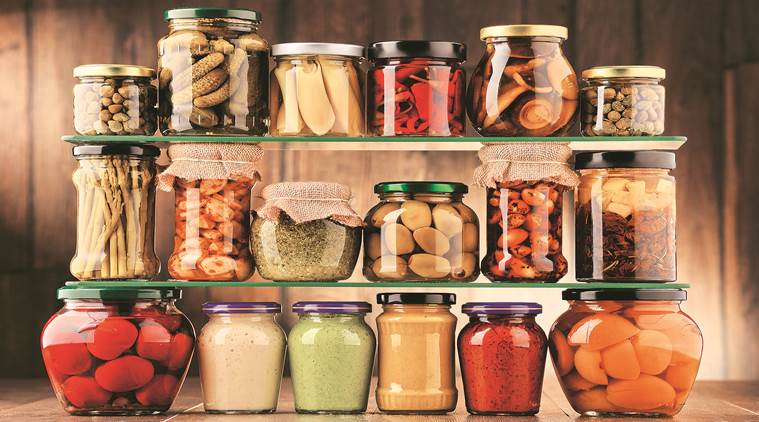 Pickling, as a way of preserving food, is almost as old as cultivation. Whenever there was a glut of a particular kind of food, it was pickled so that it could be eaten during the lean months of the year. (Source: Getty/Thinkstock)
Pickling, as a way of preserving food, is almost as old as cultivation. Whenever there was a glut of a particular kind of food, it was pickled so that it could be eaten during the lean months of the year. (Source: Getty/Thinkstock)
Durga Sivaram can pickle anything. “Starfruit, bamboo shoot, soya chunks. Whatever you give me, I will make a pickle out of it,” declares the Pune-based homemaker. The 59-year-old is well known in her circle for making any kind of pickle and frequently takes orders from family and friends. One New Year’s Eve, a few years ago, at a dinner she was hosting at home, she served a large bowl of pickle that was wiped clean before the end of the meal. “My guests loved it. They kept asking me what pickle it was, and I told them to guess. They finished the bowl, but they couldn’t guess,” she says. So, what was the pickle made of? “Green apple,” she says, laughing.
Can everything that grows under the sun be pickled? Even a cursory survey of Indian pickles indicates that this may indeed be the case. Unripe mangoes? Of course. Limes and lemons? But, obviously. These are some of the most popular types of pickles that the Indian subcontinent produces, consumes and exports. Then there are the only slightly less popular pickles made of red chillies, green chillies, Indian gooseberry (amla), garlic and some that use a medley of seasonal vegetables, such as the staple north Indian winter pickle made of cauliflower, carrots and turnips (gobhi, gaajar, shalgam ka achaar).
But these are, one might say, merely the protective layer of oil that tops the pickle; to truly understand the Indian achaar tradition, one needs to plumb deeper. One needs to, as is the case with nearly everything in Indian food, sample pickles specific to certain regions because even if they’ve been reduced to mere condiments on the modern Indian menu, good pickles speak eloquently about what the people making them eat and what they value. And so you have the stunning array of Indian pickles made of ingredients such as roselle leaves (gongura), bamboo shoot, fiddlehead fern, bhut jolokia, fish, banana stem, pork, prawns, elephant yam or any of the thousands of other kinds of foods that find their way onto the Indian plate.
Pickling, as a way of preserving food, is almost as old as cultivation. Whenever there was a glut of a particular kind of food, whether a fruit or a vegetable or a kind of meat, it was pickled so that it could be eaten during the lean months of the year. Different produce was pickled at different times of the year; for example, mangoes in summer and root vegetables like daikon radish (mooli) and carrots in winter. No pickling was done during the monsoon months because the humidity and inadequate sunlight would make it difficult to keep the pickles from spoiling.
Given how essential this practice was to stock food, it’s no wonder that the practice of pickling, albeit in different techniques, seems to have developed independently in different parts of the world. According to the pickle history timeline on the New York Food Museum’s website, cucumbers imported from their native India were pickled in vinegar by Mesopotamians as far back as 2400 BC. In Pickles, A Global History (2018), Jan Davison writes that “among the world’s earliest recorded recipes, inscribed on clay tablets some 4,000 years ago, are several which call for siqqu, a sauce prepared from pickled fish or locusts.”

But, she notes, the earliest mention of pickled vegetables appears in a Chinese manuscript over 9,000 years old. “Throughout history, pickling has been relied upon both to conserve foods and add to their savour,” Davison writes, “They are a food of great emperors and the poorest of peasants. Pickles were an intrinsic part of dining among the elite in imperial Rome and medieval Baghdad. Yet, throughout history, pickling has provided essential food for the masses. In ancient China, pickled vegetables sustained workers building the Great Wall; and, in much of Europe, pickled fish, cabbage and cucumbers once formed the mainstay of the diet — so much so that the Lithuanians created Roguszys: the god of pickles”.
In the Indian subcontinent, unlike in other parts of the world, pickling with oil emerged as the dominant technique. Davison writes, “In India, Pakistan and Bangladesh, pickles are prepared in mustard or sesame oil combined with salt and spices. The most popular pickles prepared this way, and exported the world over is mango. The green, unripe mangoes may be left whole, stuffed with spices, sliced, grated, raw or cooked…The hot sunny days are exploited in making the pickles. Often, the fruit and vegetables are salted and dried out in the sun before being packed in jars with spices and oil. The jars of pickles are placed back in the sun for up to one month, which aids preservation: the light and heat destroy mould spores and bacteria.”
Pickles are mentioned in various texts from ancient and medieval India, as well as in the accounts of travellers to the region. According to historian Jyotsna K Kamat’s Social Life in Medieval Karnataka (1980), the 14th century Kannada treatise, Nala Champu, mentions “pickles of green and raw bilva (bellavatta) or bel, ambate, chellakai, green mango, green pepper, raw ginger, raw cardamom and myrobalan were in vogue,” addding that, “Ibn Batuta, who had observed the popularity of pickles throughout India, explains the method of its preservation.”
In Indian Food: A Historical Companion (1994), food historian KT Achaya writes, “Nemichandra, in his Lilavati of about AD 1170, mentions serving to the king, Nilapati, on a lotus lea, a large number of pickles, made from fruits, vegetables and roots, all flavoured with camphor.” Achaya also notes that the Lingapurana by Gurulinga Desika (AD 1594), from what is now modern-day Karnataka, mentions 50 kinds of pickles, while the Gujarati text Varanaka-Samuchaya (AD 1520) describes pickles including, “…the distinctive athanu, goondas and chundo, with its sweet-sour flavour, tempered with cardamom and cloves.”
In Curry: A Tale of Cooks and Conquerors (2005), Lizzie Collingham writes of European travellers to 17th century India discovering the vast array of pickles and chutneys that Indians had as accompaniments to their meals. “Pietro della Valle, who had so much trouble finding anything to eat while travelling in India, equipped himself for his journey with ‘many Vessels of conserves of the Pulp of young Indian cane, or Bambu (which is very good to eat after this manner) and of green Pepper, Cucumbers and other Fruits, wont to be pickled by them’,” she writes, adding that European sailors bought jars of Indian achars to carry on sea voyages, a practice that “must have greatly improved their diet of dry, and usually wormy, biscuits and hard salt meat.”
According to Collingham, as the British established dominion over India, among the many Indian culinary features that cooks back in Old Blighty eagerly adopted was that of Indian pickles. “Indians very rarely used vinegar, and their pickles were made by layering vegetables or fruits in jars with oil or water. The mixture was flavoured with salt and spices and the jars were set in the hot sun where they were left to ferment. Lacking the intense heat of the Indian sun, British cooks resorted to vinegar to carry out the pickling process. Unable to lay their hands on mangoes or bamboo shoots, they tried out various substitutes such as marrows, apples or tomatoes for mangoes and elder shoots for bamboo.” Particularly popular, she writes, was what came to be known as piccalilli. “The bright yellow mixture of cauliflower, onions and mustard…almost certainly evolved out of these recipes. While curries made few inroads into British working-class households, jars of pickle became standard in all British pantries…”
Anyone from the Indian subcontinent, who has drizzled achaar ka tel over a plate of steaming hot khichdi or has scraped, in a foreign land and with growing desperation, the bottom of a bottle of lime pickle for the last delicious dregs, would agree that this form of preservation attained the level of culinary art in this land. This may be because, as Sangeeta Khanna, food consultant and writer of Pakodas: The Snack for All Seasons (2019) says, in India, pickling wasn’t just a form of preservation. “It has always been treated as a condiment. You wouldn’t pickle just any fruit or vegetable. It had to be the best produce and it had to taste good,” she says.
Pickles were an important part of the meal, says Khanna, because they completed the shadrasa (six tastes — sweet, sour, pungent, astringent, bitter and salty) requirement as prescribed by ayurvedic texts. The strong flavour and aroma of pickles activated the salivary glands, and helped in digesting the meal.
In fact, Khanna says, certain pickles were made for their therapeutic value. “Ayurvedic texts talked about pickles as ‘agni pradeepak’, meaning that they improved the ‘fire’ in your system. By this, they probably meant that the pickles improved metabolism.” Pickles like the aged, blackened lime pickles found in north India, or the salted kokum or tamarind pickles found down south were meant to aid digestion, says Khanna. Pallavi Chaturvedi, who makes and sells pickles under the brand Courtyard Memories, swears by the jar of 42-year-old kaala nimbu ka achaar, which has disintegrated into a chooran (powder), to treat any digestive ailments. “In my house, instead of antacids, we eat a little bit of this pickle whenever we have digestive problems. It helps a lot,” she says, “It was made by my grandmother and there are very few people remaining who know how to make it. Lime is pickled with lots of different medicinal herbs and spices and it takes at least a year for it to become a chooran.”
 Spice them right: Mango, chilli and lime pickles. (Source: Getty/Thinkstock)
Spice them right: Mango, chilli and lime pickles. (Source: Getty/Thinkstock)
It isn’t just the Indian subcontinent that values pickles for their often therapeutic properties, though. In her book, Davison notes pickled cabbage was recommended as a cure for “disease of the joints” by the second-third century BC Roman senator and historian, Cato the Elder, in his Liber de agricultura (c. 160 BC). “In the 18th century, sauerkraut, rich in vitamin C, was identified as preventing scurvy, the bane of every seagoing nation. Fermented pickles, produced through the action of lacto-acid bacteria, are probiotic: their consumption is beneficial to the digestive system, and, it seems, also, to the lymphatic and immune systems. Some possess both anti-ageing and anti-cancer properties,” writes Davison.
If we’re honest with ourselves, though, we don’t eat pickles for our health. Often, we eat them because one whiff from the pickle bottle is enough to telegraph to us all that we love about the food we’ve grown up eating. Anthropologist Arjun Appadurai, in his paper “How to Make a National Cuisine: Cookbooks in Contemporary India,” wrote that “…cookbooks appear to belong to the literature of exile, of nostalgia and loss.” One could argue that pickles, in a way, are a “food of exile”, the easiest form in which we can carry the flavours of home with us, no matter where we go. Sushmita Subba who, along with her mother and brother, runs Auks Farms in Darjeeling, recalls the beef pickle that her late father used to make and which she would carry with her whenever she returned to her boarding school in Bengaluru. For Subba, that pickle is a reminder of home, and, years later, when she started making pickles from the surplus produce grown at her homestay, she began making the pickle — with chicken instead of beef — as a tribute to her father. “I even used to tell the story of my father and this pickle, and all the memories that it holds for me, in the packaging of the products, because, for me, there’s a strong emotional connection to it,” she says.
Pickles are also traditional knowledge in a bottle, and learning to make pickles is a way of honouring that. Chaturvedi found that out when she learned to make the prawn-and-mutton pickle that her Punjabi husband’s grandfather used to make and sell at his hotel in Solan. “I’m a strict vegetarian. It was only three years ago that I decided I must try makeing these, too, otherwise the recipes will be lost,” she says. Chaturvedi says that her mother-in-law’s eyes “lit up with joy” when asked to share the recipes. “Since Nanaji passed away, she was the only person who knew how to make these pickles and she was happy to share the knowledge,” she says.
Given changing lifestyles that finally permitted many women, at least in urban centres, to spend less time in kitchens, the last few decades have seen a large market for factory-made pickles, often sold with the promise of a taste of “home”. In recent years, however, thanks to a conjunction of factors — growing number of small entrepreneurs, especially women from rural India, a food consumption culture that prizes the “authentic experience” and a curiosity about “traditional” foods among home cooks and chefs — homemade pickles are finding a market as well.
But then, “tradition” can frequently be a heavy, oppressive word,especially for women. In the domestic space, preparing and making food — especially the time and energy-intensive work of making pickles, papads and wadis — was typically women’s labour. The women of the house would get together and spend many hours selecting the best produce, preparing it and laying it out to dry in the sun, cleaning and grinding masalas. Which is why, squaring something as labour-intensive as pickle-making, with a modern celebration of food traditions is not a simple matter.
As Chris Mary Kurian, a home cook and caterer, points out, all food-making was traditionally invisible labour and, with a few exceptions in urban, middle-class families, remains so. “Food has become an important part of being a cosmopolitan Indian. So, urban consumers are looking for traditional, homemade foods,” she says. But the emphasis remains on the consumption of these foods and not so much on the making, which is why the labour that goes into these preparations remains invisible and undervalued. Kurian sells her homemade pickles through the NGO Dastkar in Delhi, and she recounts the many times that customers have questioned her pricing. “They care about two things. One is the price and the other is the freshness. But if you want freshness, there’s a lot of labour involved, and that needs to be acknowledged in how much we pay for it,” she says.
Whether made in factories or boutique enterprises by women who are finally learning that they can get what they deserve for their culinary skills, pickles continue to be an important part of the Indian pantry. And, occasionally, one lucks into a friend or acquaintance like Sivaram. She says that she’s reluctant to sell her pickles, even when urged by family and friends to do so. “I make pickles because it’s like therapy to me,” she says, “besides, it’s the kind of gift that people always appreciate.”
Recipes
Singhade ka achaar
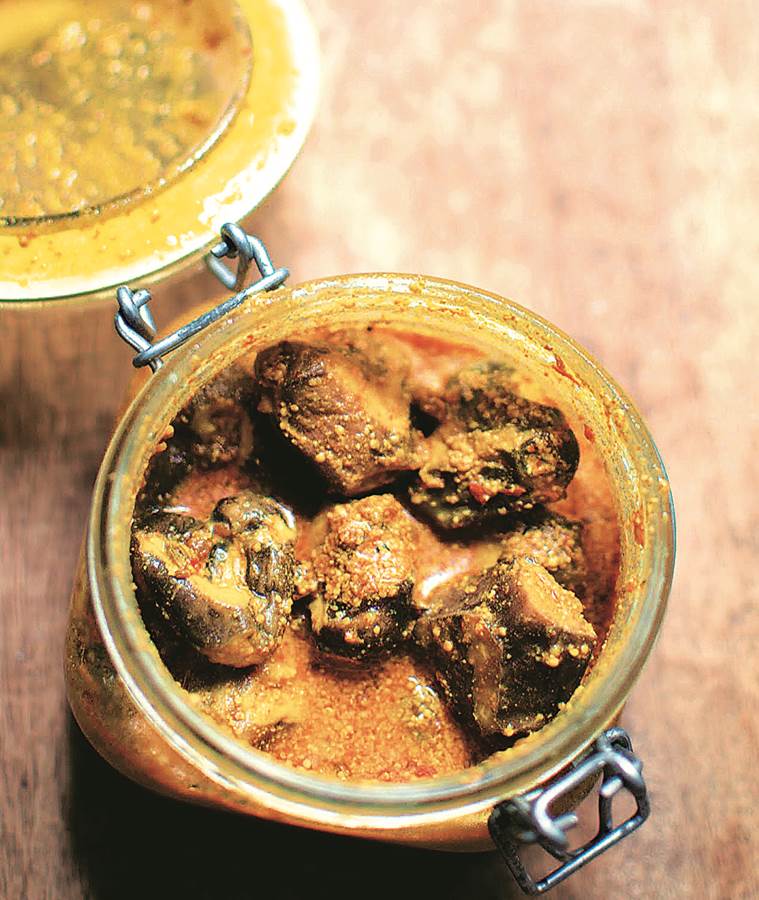 Find out how you can prepare this delicious pickle.
Find out how you can prepare this delicious pickle.
Water chestnuts (singhada) — 500 gm
Turmeric powder — 2 tsp
Yellow mustard powder — 2 tbsp
Whole fennel seeds (saunf) — 1 tbsp
Fenugreek seeds (methi) — 2 tsp
Carom seeds (ajwain) — 1 tsp
Nigella (kalonji) — 1 tsp
Red chilli powder or to taste — 2 tsp
Mustard oil — 2 tbsp
A pinch of asafoetida (hing)
Salt — 15-20 gm (less, if you want to eat this with every meal)
Steps:
* Rinse and clean the water chestnuts. Drain. No need to dry in the sun.
* Peel the water chestnuts. You can also just remove the thorns and cut the water chestnuts in two halves lengthwise.
* Boil enough water in a deep pan to submerge all the water chestnuts. Add a little salt (1 tsp per litre) and tip in the water chestnuts in boiling water at once. Wait for 2 minutes and drain the hot water.
* Add the salt and turmeric powder to the water chestnuts and toss to mix. Now, add the mustard powder, too. Toss and keep aside.
* Heat mustard oil in a pan, add the asafoetida, fenugreek seeds and nigella seeds one by one, waiting a few seconds before the spices start sizzling. Then, add the fennel and carom seeds together and remove the pan from stove.
* Mix well, add the red chilli powder and pour the spice mix over the water chestnuts. Mix well to coat them all and fill in a sterile glass jar. The pickle will be ready to eat in 2-3 hours.
* Refrigerate after about 4 hours. This pickle keeps well for 2-3 weeks when refrigerated . At room temperature, it lasts for a couple of days. Adding more salt and mustard oil can make it stable at room temperature.
(Courtesy: Sangeeta Khanna)
Pork Pickle
Pork — 2 kg
Mustard oil — 1 litre
Roasted cumin — 150 gm
Ginger — 50 gm
Garlic — 100gm
Red pepper — 200gm
Brown sugar — 1 teaspoon
Juice from seven whole lemons
Salt to taste
For marination:
Soy sauce — 1 tablespoon
Chilly powder — 50gm
Salt — 1/2 teaspoon
Steps:
* Wash, clean and drain the pork. Cut them into medium sized cubes.
* Add soy sauce, chilly powder, three tablespoons of lime juice and salt. Mix well and marinate overnight.
* Heat mustard oil in a pan. Add the marinated pork and fry till the pork pieces are light brown in colour. In the same oil, sauté the ginger and garlic separately until they turn golden brown. Then fry the red pepper.
* Dry roast the cumin seeds till they turn slightly brown and grind them.
* Roughly grind the fried red pepper.
* In a large bowl, put the pork pieces and all the other ingredients and mix thoroughly. Add the remaining lemon juice, brown sugar and salt and mix.
* If there is some oil remaining after frying the meat and other ingredients, you can add it to the bowl after the oil cools down. Mix thoroughly.
* Transfer the pickle to clean dry bottles. These can be stored for three months or more if you refrigerate them.
(Courtesy: Sushmita Subba)
Lemon Peel
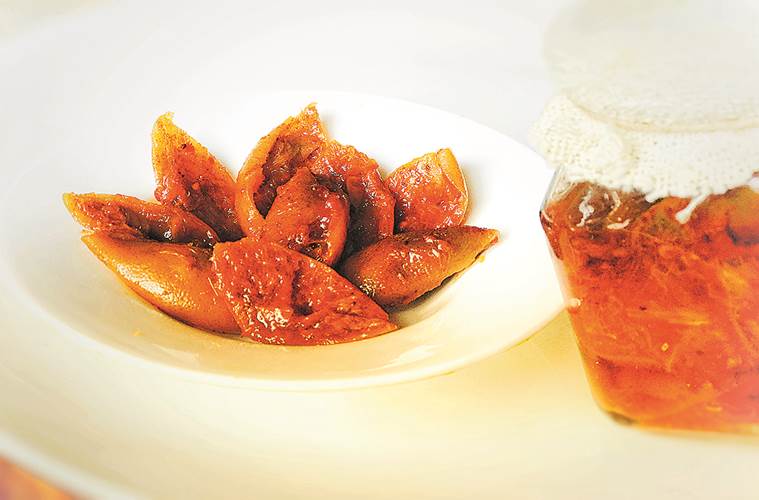 Learn how to make this lip-smacking pickle.
Learn how to make this lip-smacking pickle.
Lemon peel without juice — 1 kg
Salt — 160gm
Asafoetida — 0.5gm
Kashmiri mirch — 20 gm
Sugar — 60 gm
Steps:
* Take the lemon halves which have been pressed for juice once. Deseed the lemons and cut it into 4 pieces.
* Put the lemon peels in a glass jar with a space of about 5 inch left (to enable shaking) and add salt.
* Keep this jar in the sun, covering it with a muslin cloth covered during the day. After sunset, keep it inside. Shake the jar every day.
* On the fourth day, add asafoetida, sugar and mirch and mix well.
* Continue keeping it in sun for about 30 days or till you feel the lemon peel is soft.
* Lime peel pickle is ready without using preservatives and oil. This will last for 6 to 8 months.
(Courtesy: Pallavi Chaturvedi)
This article appeared in the print edition with the headline ‘SALT, FAT, ACID, HEAT’
May 02: Latest News
- 01
- 02
- 03
- 04
- 05






